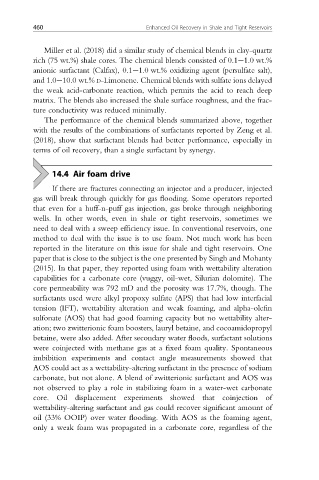Page 496 - Enhanced Oil Recovery in Shale and Tight Reservoirs
P. 496
460 Enhanced Oil Recovery in Shale and Tight Reservoirs
Miller et al. (2018) did a similar study of chemical blends in clay-quartz
rich (75 wt.%) shale cores. The chemical blends consisted of 0.1e1.0 wt.%
anionic surfactant (Calfax), 0.1e1.0 wt.% oxidizing agent (persulfate salt),
and 1.0e10.0 wt.% D-Limonene. Chemical blends with sulfate ions delayed
the weak acid-carbonate reaction, which permits the acid to reach deep
matrix. The blends also increased the shale surface roughness, and the frac-
ture conductivity was reduced minimally.
The performance of the chemical blends summarized above, together
with the results of the combinations of surfactants reported by Zeng et al.
(2018), show that surfactant blends had better performance, especially in
terms of oil recovery, than a single surfactant by synergy.
14.4 Air foam drive
If there are fractures connecting an injector and a producer, injected
gas will break through quickly for gas flooding. Some operators reported
that even for a huff-n-puff gas injection, gas broke through neighboring
wells. In other words, even in shale or tight reservoirs, sometimes we
need to deal with a sweep efficiency issue. In conventional reservoirs, one
method to deal with the issue is to use foam. Not much work has been
reported in the literature on this issue for shale and tight reservoirs. One
paper that is close to the subject is the one presented by Singh and Mohanty
(2015). In that paper, they reported using foam with wettability alteration
capabilities for a carbonate core (vuggy, oil-wet, Silurian dolomite). The
core permeability was 792 mD and the porosity was 17.7%, though. The
surfactants used were alkyl propoxy sulfate (APS) that had low interfacial
tension (IFT), wettability alteration and weak foaming, and alpha-olefin
sulfonate (AOS) that had good foaming capacity but no wettability alter-
ation; two zwitterionic foam boosters, lauryl betaine, and cocoamidopropyl
betaine, were also added. After secondary water floods, surfactant solutions
were coinjected with methane gas at a fixed foam quality. Spontaneous
imbibition experiments and contact angle measurements showed that
AOS could act as a wettability-altering surfactant in the presence of sodium
carbonate, but not alone. A blend of zwitterionic surfactant and AOS was
not observed to play a role in stabilizing foam in a water-wet carbonate
core. Oil displacement experiments showed that coinjection of
wettability-altering surfactant and gas could recover significant amount of
oil (33% OOIP) over water flooding. With AOS as the foaming agent,
only a weak foam was propagated in a carbonate core, regardless of the

